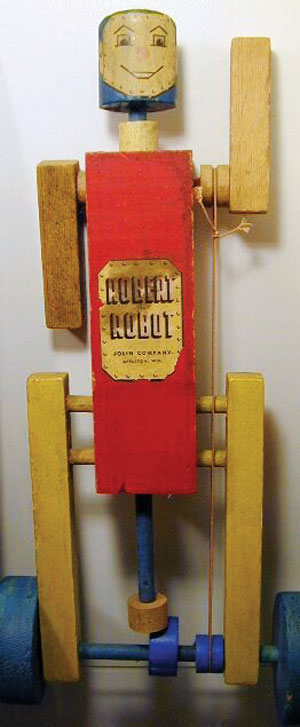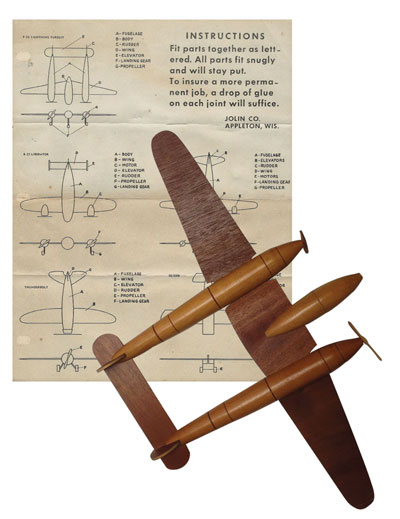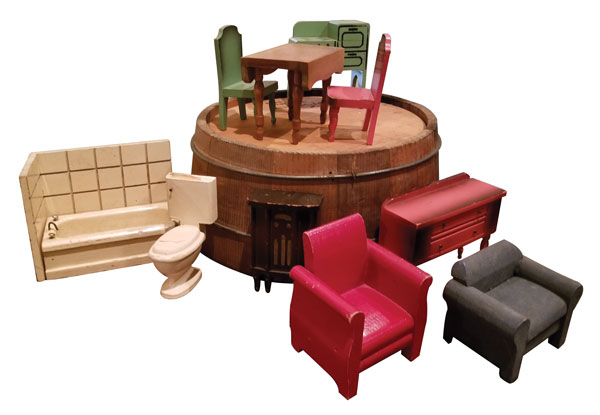Vintage Toys from the Valley
The Fox Cities were once a toymaking hot spot
 Toys—they simply don’t make them like they used to. Not only are modern plastic toys a departure from the wooden and fabric designs of yesteryear, but many people aren’t aware that the industry model used to be much more localized. Those who grew up in the Fox Valley might be surprised to find their vintage rocking horse, dollhouse or toy airplane was actually made locally, part of a once-abundant toymaking industry.
Toys—they simply don’t make them like they used to. Not only are modern plastic toys a departure from the wooden and fabric designs of yesteryear, but many people aren’t aware that the industry model used to be much more localized. Those who grew up in the Fox Valley might be surprised to find their vintage rocking horse, dollhouse or toy airplane was actually made locally, part of a once-abundant toymaking industry.
Fortunately, organizations like the Appleton and Neenah Historical Societies and Appleton’s History Museum at the Castle have worked to uncover many local companies that once put toys in the hands of Fox Cities children between approximately 1882 and the 1990s.
The History Museum at the Castle hosts “Play: the Golden Age of Toys,” an exhibit which chronicles Appleton’s toymaking history through a variety of vintage toy displays. Curator Emily Rock says the exhibit is a great way to get people thinking about local history through a familiar, nostalgic topic.
“This exhibit showcases a great piece of lost local business and industrial history,” she says. “Many people may not know that Appleton had toy factories, and that some of those toys were distributed nationally. Plus, it’s toys—people love toys.”
Rock wanted the exhibit to have an authentic toyshop feeling, but with a “wonderful, whimsical, playful look.” On formost display is a cartoonish storefront, labeled “Wolman’s Bazaar,” which includes a number of vintage toys that likely would have appeared in an old toy or general store.
“The Wolman’s Bazaar was a popular toy store that sold a variety of things including toys, so we modeled it after that,” Rock says.
Behind the storefront’s glass, a Raggedy Andy doll gazes out the shop window sitting atop a high chair made by Hortonville-manufactured American Toy and Furniture (1940s-1990s). On the other side, a small sled made by the Appleton Toy and Furniture Company (1882-1965) takes center stage.
“These toys are from all different eras, but I just love the effect of it, and it was really fun to put together,” Rock says.
Elsewhere in the exhibit are several toys displayed in glass cases, including the “Bronko Pony,” an Appleton Toy and Furniture Company variation on the rocking horse with stationary pegs for front legs.
Other local toys on display came from Toy Company of America (1920-25), known for juvenile furniture, animal toys and dollhouses, and Appleton Wood Products Company, known for large blocks called “Happy Builders.”
Some local toys had more complex functions, like Jolin Toy Company’s wooden airplane featured in an exhibit at the Appleton Historical Society Museum. This design, produced from 1943 to 1947, was heavily influenced by World War II. Appleton Historical Society board member Mark Moderson says these model planes were designed to be as authentic to their real-life counterparts as possible for training purposes.
“Jolin made [model plane] kits during World War II and sent them to army post for observers to use as examples,” Moderson says.
Using the models for references, military personnel were trained to spot enemy planes over American skies. The planes were even packed with diagrams that labelled its specific parts. Practicality and economic conditions also influenced the toy’s wood-only design, Moderson says. Because the owners of Jolin also operated a hardwood plant in Gillett, WI, toy production came from leftover wood products.
The popular wooden aesthetic commonly associated with 1940s-era toys was not only by choice, but necessity, since wartime rationing practices limited the use of critical resources in the toy industry. Jolin Company, whose model airplanes and toy robots were made entirely of wood, was no exception.
“The wheels were made out of wood,” Moderson says. “Certain materials were needed for the war, so they couldn’t use metal or rubber. Because of that toys were made out of a lot of simple parts.”
Additionally, the Neenah Historical society features toys from Menasha Wooden Wares, now Menasha Corporation, in their “Shopping in the Neighborhood” exhibit. Several pieces of tiny doll furniture are on display, including wooden chairs, tables and cabinets.
Jane Lang, Neenah Historical Society executive director, says narrowing down the company’s short-lived toy manufacturing stint between 1929 and 1942 took a great deal of research.
“We have, over the past few years, been undertaking the arduous task of identifying every object in our collection and attempting to match it with paperwork,” Lang says.
Despite the challenges that go into uncovering lost history, Lang says the task is important in enabling the community to better understand its local history.
“Understanding the history of the toy industry is similar to what can be gained by a general understanding of a community’s history,” Lang says. “Learning about what took place … helps us to widen our understanding of the interrelationships that continue to influence our community.”
Learn more about vintage toys in the Fox Cities by visiting The History Museum at the Castle, the Appleton Historical Society Museum and the Neenah Historical Society.










Leave a Comment